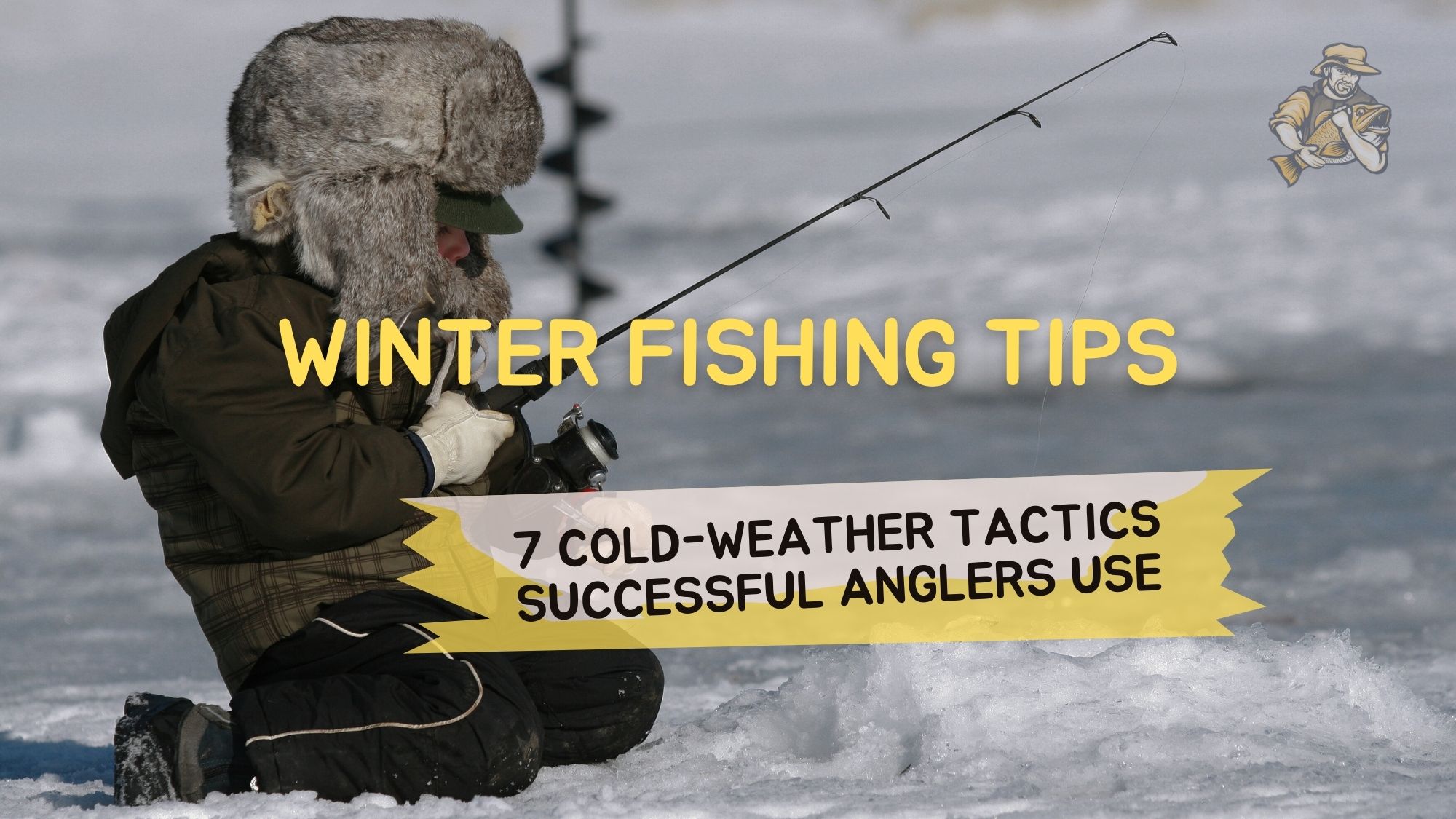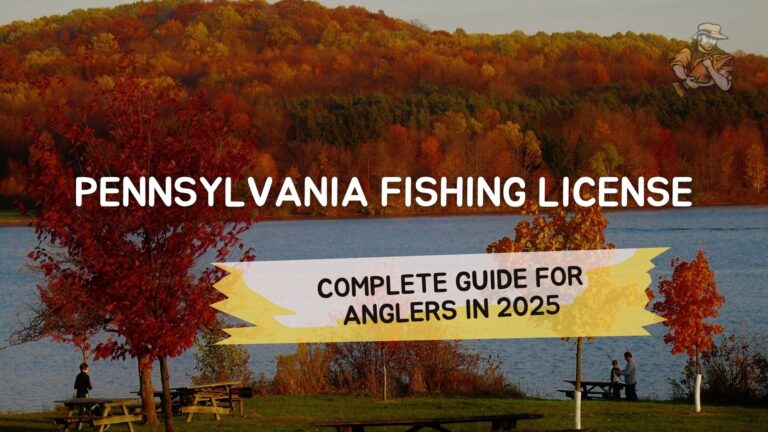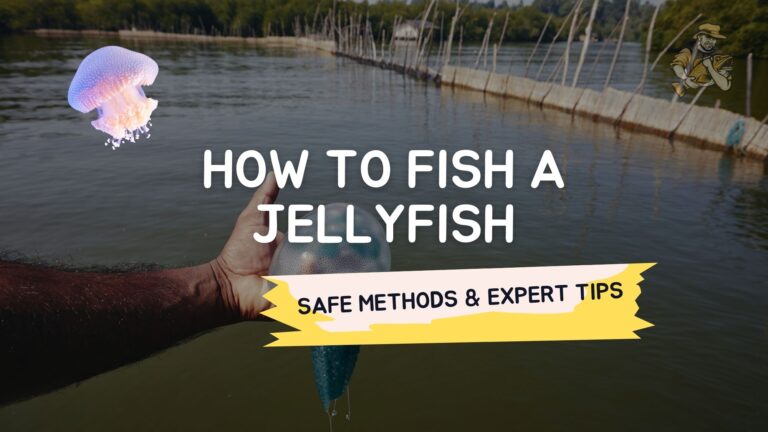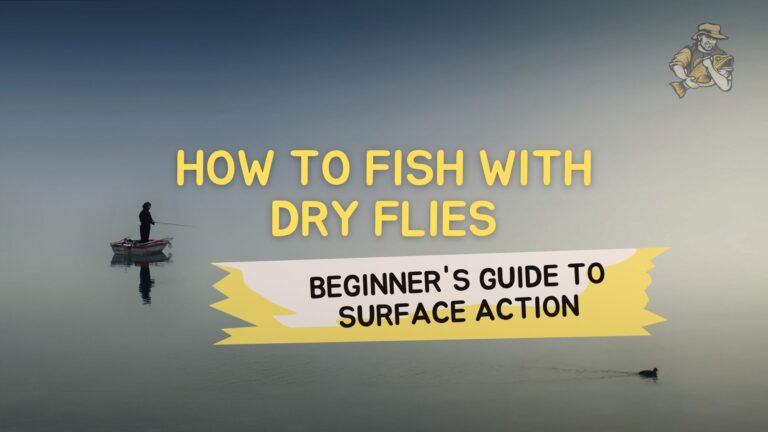Winter Fishing Tips: 7 Cold-Weather Tactics Successful Anglers Use
By Adam Hawthorne | Last Modified: April 27, 2025

Most anglers pack away their gear when the temperature drops, but the dedicated few know something the others don’t: winter fishing can be incredibly rewarding if you know what you’re doing. I’ve spent over three decades braving the cold waters of Michigan and beyond, and I’m here to share the winter fishing tips that actually produce results when everything seems frozen.
Winter fishing requires adjustments – but the peace, solitude, and surprisingly good catches make it worth the extra effort. Trust me on this one.
Winter Fishing Tips for Cold-Weather Success
Winter fishing success comes down to understanding how fish behavior changes in cold water. Most species slow down dramatically, becoming less active and more selective about when and what they’ll eat. Your summer tactics simply won’t cut it when the mercury drops.
I learned this lesson the hard way about fifteen years ago on Lake St. Clair. I stubbornly used my favorite summer lures and retrieval speeds on a frigid January day, resulting in exactly zero bites over eight frustrating hours. The next day, I slowed everything down, downsized my presentation, and caught my limit of walleye by noon. Sometimes the fish have to teach you directly.
Let’s dive into the seven cold-weather tactics that consistently produce results when most anglers are sitting at home.
1. Slow Down Your Presentation
Fish metabolism slows significantly in cold water, making them less likely to chase fast-moving lures. One of the biggest mistakes I see winter anglers make is retrieving at the same speed they use during warmer months.
When the water temperature drops below 45°F, I cut my retrieval speed by at least half. Sometimes I’ll even count to three between each reel turn to ensure I’m moving slowly enough. This patience can test your resolve, but it’s essential for winter success.
My son Tommy learned this lesson last winter when we were fishing for pike on Lake Huron. He kept retrieving too quickly out of habit and caught nothing for hours. When he finally slowed down to what felt like a painfully sluggish pace, he hooked into a 38-inch pike within ten minutes.
For species like walleye and perch, sometimes the best “retrieve” is barely moving at all – just enough to provide some occasional action while keeping your bait in the strike zone.
2. Downsize Your Bait and Tackle
Cold-water fish rarely feed aggressively, preferring smaller, easier-to-digest meals during winter. I’ve found downsizing both bait and tackle to be extremely effective when temperatures drop.
For example, if I typically use 4-inch swimbaits for bass in summer, I’ll switch to 2-inch versions in winter. The same principle applies across all species – smaller presentations almost always outperform larger ones in cold water.
Line diameter matters too. I typically drop down at least one size from my warm-weather line. If I use 10-pound test in summer, I’ll switch to 6 or 8-pound in winter. The thinner diameter cuts through the water more easily and provides better feel for those subtle winter bites.
Terminal tackle should follow this downsizing principle too. Smaller hooks, lighter weights, and more compact presentations will consistently outperform their larger counterparts when the water gets cold.
I keep a separate tackle box specifically for my winter fishing gear with downsized versions of my favorite lures. This keeps me from being tempted to use the wrong sizes when I’m on the water.
3. Target Afternoon Hours and Sunny Days
Timing becomes crucial during winter months. Unlike summer fishing where dawn and dusk typically produce the best results, winter fishing often peaks during mid-afternoon hours when the water reaches its warmest point.
I’ve noticed this pattern consistently on lakes across Michigan. My most productive winter fishing has almost always occurred between 11am and 3pm, especially on sunny days when the water absorbs whatever heat is available.
Water temperature can vary by several degrees between morning and afternoon in winter. This slight warming can trigger feeding activity in otherwise lethargic fish. On several occasions, I’ve caught nothing all morning only to have the bite turn on like someone flipped a switch around 1pm.
During a particularly cold February day on Lake Erie a few years back, the surface temperature rose from 33°F to 36°F between morning and mid-afternoon. That modest 3-degree increase triggered an impressive walleye bite that lasted until sunset. The temperature difference wasn’t much, but it was enough to activate the fish.
Sunny days can also create warm micro-environments around dark objects that absorb heat. Rocks, fallen trees, and other dark structure can become fish magnets as they warm the surrounding water slightly.
4. Find Deep Water Adjacent to Shallow Feeding Areas
Fish location patterns shift dramatically in winter. Many species retreat to deeper water where temperatures remain more stable, but they’ll move to adjacent shallow areas during prime feeding periods.
Look for areas where deep water access (winter holding zones) lies close to potential feeding zones. Points that extend into deeper water, channel edges near flats, and deep holes adjacent to shallow structure are prime winter locations.
Some of my best winter fishing has come from targeting these transition areas between deep wintering holes and shallower feeding grounds. Fish won’t travel far in cold water, so finding spots where they can access both deep sanctuary and food with minimal movement is crucial.
Lake Michigan has taught me this lesson repeatedly. During winter months, I’ve had great success targeting the steep drop-offs where deep basin areas meet shallower structural elements. The fish hold in the depths but make short feeding forays to the adjacent structure.
This pattern works across species, from walleye and perch to bass and pike. Each may use slightly different depth ranges, but the principle of finding deep-shallow transitions remains consistent.
5. Master the Art of Vertical Jigging
Vertical jigging becomes increasingly effective as water temperatures drop. This technique allows for precise bait placement and subtle presentations that winter fish find irresistible.
The beauty of vertical jigging is control – you can keep your presentation directly in front of fish and make minute adjustments to trigger strikes. When fish are lethargic, sometimes the smallest movements produce the biggest results.
I spent a week ice fishing with my brother James on Lake Superior a few winters ago, and we conducted an impromptu experiment with our jigging cadence. The difference between a 1-inch lift and a 3-inch lift was the difference between constant action and getting completely skunked. Sometimes these tiny adjustments make all the difference.
For open-water winter fishing, I’ll often position directly above fish I’ve marked on my sonar and work a vertical presentation rather than casting. This provides maximum control and helps maintain the slow, subtle action that cold-water fish prefer.
Here’s a basic vertical jigging approach that works well for me:
- Use sensitive equipment to detect subtle takes
- Try lifting your jig just 1-2 inches, then let it fall on slack line
- Experiment with holding completely still for several seconds between movements
- Watch your line for any slight movement indicating a take
The first time I really focused on perfecting my winter jigging cadence, my catch rate quite literally tripled. It’s that important.
6. Use Electronics to Find Congregated Fish
Winter tends to concentrate fish in predictable areas, making electronics more valuable than ever. In cold water, finding the fish becomes the primary challenge – once located, catching them is often straightforward using the techniques we’ve discussed.
Modern sonar and GPS systems have completely transformed winter fishing. Areas that would have required days or weeks to locate can now be identified in hours.
I resisted upgrading my electronics for years, stubbornly relying on old-school knowledge. When I finally invested in a quality sonar system with side-imaging about five years ago, my winter success improved dramatically. Technology isn’t a replacement for experience, but it’s certainly a powerful tool when used properly.
In winter, I spend more time searching and less time fishing until I locate active fish. This might sound counterintuitive, but it’s far more productive than blindly fishing unproductive water. Once you find a concentration of fish, you can often return to the same general area throughout the winter season.
Some specific features I look for on sonar during winter:
- Tight groups of fish (winter often concentrates them)
- Fish positioned slightly off the bottom rather than directly on it
- Subtle structure elements like small depth changes or hard-bottom transitions
- Baitfish schools (predators won’t be far away)
My fishing buddy Mark refused to use electronics for years. Last winter, after watching me consistently outfish him by targeting congregated fish I’d found on sonar, he finally relented and got his own unit. His first text to me after using it solo: “I’ve wasted a decade fishing empty water.”
7. Adapt Your Tackle for Cold-Weather Comfort
Effective winter fishing isn’t just about techniques – it’s also about staying comfortable enough to execute them properly. Cold hands miss subtle bites, and if you’re too miserable to stay focused, you’ll miss opportunities.
I’ve learned to modify my equipment specifically for winter comfort:
- Oversized reel handles to accommodate gloved hands
- Rod holders for hands-free fishing when fingers need warming
- Cork handles rather than EVA foam (cork doesn’t conduct cold as readily)
- Longer rods that keep line away from ice buildup in rod guides
Something as simple as stretching surgical tubing over your rod handles provides additional insulation against the cold. This tiny modification has saved my hands during many frigid Michigan mornings.
I even apply a thin layer of ChapStick to my rod guides on particularly cold days to prevent ice buildup that can freeze line and inhibit casting. This old ice fishing trick works remarkably well for open-water winter fishing too.
Last winter, my neighbor joined me for his first cold-weather fishing experience on Lake Huron. He showed up with his standard equipment and was constantly fighting frozen guides and numbing hands. Halfway through the trip, I rigged him with my winter-modified backup rod. His exact words: “I can actually feel the fish now instead of just my frozen fingers.”
The Magic of Winter Fishing
These seven tactics have transformed my winter fishing from an occasional desperate attempt to satisfy the fishing itch into some of my most productive and enjoyable angling of the year. While fair-weather fishermen miss out, those willing to brave the elements often experience the best quality fishing of the season.
I’ve caught some of my largest fish during the winter months, including my personal best walleye and lake trout. The reduced fishing pressure certainly plays a role in this success – the fish see fewer lures and experience less stress during cold months.
Winter fishing also provides a unique opportunity to enjoy nature in its most peaceful state. On a quiet January morning on a remote Michigan lake, with steam rising from the water and not another angler in sight, you’ll experience a connection to the natural world that’s increasingly rare in our busy lives.
Winter Fishing FAQs
What’s the best way to dress for winter fishing?
Layering is absolutely crucial. I start with moisture-wicking base layers, add insulating mid-layers (fleece or wool), and finish with a waterproof, windproof outer shell. Quality waterproof gloves and insulated, waterproof boots are non-negotiable. I’ve found that thin liner gloves under fingerless fishing gloves provide a good balance of warmth and dexterity. Don’t forget a good hat – you lose tremendous body heat through your head.
Is winter fishing dangerous?
Winter fishing requires additional safety precautions, but it’s not inherently dangerous if you’re properly prepared. Always fish with a partner when possible, wear a life jacket, and let someone know where you’ll be and when you plan to return. Check weather forecasts diligently, and be willing to cut trips short if conditions deteriorate. For ice fishing specifically, always check ice thickness regularly and carry ice safety picks.
What species are best to target during winter?
In the Great Lakes region, walleye, pike, perch, and lake trout remain active throughout winter and often provide excellent fishing. Trout in general tend to feed well in cold water. Bass fishing becomes more challenging but is still productive with adjusted techniques. Panfish like bluegill and crappie can offer fantastic winter action, especially through the ice. Steelhead in tributary streams can provide world-class fishing on milder winter days.
Do I need special gear for winter fishing?
While specialized gear isn’t absolutely necessary, certain modifications improve both comfort and effectiveness. Reels with oversized handles accommodate gloved hands, while rods with cork handles provide better insulation against cold. Line choice becomes more critical – fluorocarbon tends to be more brittle in extreme cold, while monofilament absorbs water and can freeze. Many winter anglers prefer braided line with a fluorocarbon leader for optimal performance.
How do I prevent my fishing line from freezing?
To prevent line freezing, apply a light coating of line conditioner before fishing. Keep your rod tip submerged when possible to prevent water from running down the line and freezing in the guides. When ice buildup occurs, temporarily remove it by pinching the line between your fingers and running them up through the guides. As mentioned earlier, a thin layer of ChapStick on rod guides can also help prevent ice accumulation.
Are artificial lures or live bait better for winter fishing?
Both can be effective, but live bait often has an edge in extremely cold conditions when fish are very lethargic. Minnows, waxworms, and mousies (larvae) are winter staples. For artificial lures, smaller profile baits with subtle action tend to outperform larger, more aggressive presentations. Blade baits, small jigging spoons, and tiny soft plastics are winter standards in my tackle box. The best approach is to have both options available and let the fish tell you what they prefer on any given day.
How can I stay warm on a winter fishing boat?
Portable propane heaters designed for boat use can make winter fishing dramatically more comfortable. Just be sure they’re approved for marine use and practice proper ventilation and safety protocols. Hand warmers placed strategically inside clothing provide targeted heat where needed. For longer trips, consider a small thermos of hot drinks – nothing restores warmth like something hot in your core. Above all, stay dry – wetness accelerates cold exponentially.
Final Thoughts on Winter Fishing Tips
Winter fishing requires adjustments to nearly every aspect of your approach, from tackle selection to time of day, but the rewards justify the extra effort. The quiet solitude, reduced fishing pressure, and opportunity to catch quality fish make cold-weather angling a special experience.
My most memorable fishing moments often come during these coldest months. There’s something magical about being the only boat on a misty winter lake, or watching your breath form clouds as you wait for that distinctive tap on your line.
For those willing to embrace the challenges, winter fishing offers unique opportunities that summer anglers will never experience. So while others store their gear and wait for spring, consider these winter fishing tips your invitation to some of the year’s most rewarding angling experiences.
Just remember to slow down, downsize, fish the afternoons, find the transitions, master vertical presentations, use your electronics, and adapt your equipment for comfort. With these seven tactics, you’ll be catching fish when others can only dream about it.

Meet Adam Hawthorne
I’m a lifelong fishing enthusiast who’s spent years exploring rivers, lakes, and oceans with a rod in hand. At Fishing Titan, I share hands-on tips, honest gear reviews, and everything I’ve learned about fish and ocean life, so you can fish smarter and enjoy every cast.
Share:

Meet Adam Hawthorne
I’m a lifelong fishing enthusiast who’s spent years exploring rivers, lakes, and oceans with a rod in hand. At Fishing Titan, I share hands-on tips, honest gear reviews, and everything I’ve learned about fish and ocean life, so you can fish smarter and enjoy every cast.
Related Articles

Pennsylvania Fishing License: Complete Guide for Anglers in 2025
Getting your Pennsylvania fishing license sorted isn’t exactly the most exciting part of fishing, but it’s absolutely necessary if you want to stay on the…

How to Fish a Jellyfish: Safe Methods & Expert Tips
Jellyfish fishing is a specialized niche within the broader world of angling that requires unique techniques, specific knowledge, and proper safety precautions. While not a…

How to Fish with Dry Flies: Beginner’s Guide to Surface Action
There’s something almost magical about watching a trout rise to sip your dry fly from the surface. I still remember my first successful dry fly…

California Fishing License Guide: Costs, Types & How to Buy (2025)
Getting your California fishing license might seem like a hassle, but it’s actually pretty straightforward once you know the ropes. I’ve been fishing across North…
